英语专业目的论指导下公示语翻译开题报告
- 格式:doc
- 大小:57.50 KB
- 文档页数:5

目的论视角下的翻译开题报告
翻译开题报告(目的论视角)
本报告是为了探索目的论视角下的翻译研究所作出的开题报告。
在翻译领域,目的论是一个重要的理论框架,它通过强调翻译行为本身所支配的社会条件来帮助翻译者和翻译研究者更好地理解了翻译过程中的概念、原则和实践。
具体而言,本研究将探讨目的论视角下的语言翻译,其中包括对文字意义、语言形式、文化背景等的考量。
在此视角下,本研究将尝试以行为主体的概念去探索翻译的涵义,重点关注翻译者的社会环境以及被翻译文本本身所具备的文化象征特性。
本报告将探究以下研究内容:(1)本研究将探讨翻译行为如何在不同社会文化环境下发生;(2)本研究将尝试建立一个理论框架,用来探讨翻译者所处社会环境如何影响其翻译行为;(3)本研究将探讨翻译行为如何影响社会文化环境。
预计本研究将采用定性与定量的研究方法,对翻译的涵义进行深入探索。
为此,本研究将采取大量的文献资料、文本分析等数据收集方法,以便获得有效的、全面的数据。
最终,本研究将模型化出一套可应用于翻译研究的目的论视角,以帮助翻译研究者更好地理解翻译的含义以及翻译行为如何受社会文化环境的影响。
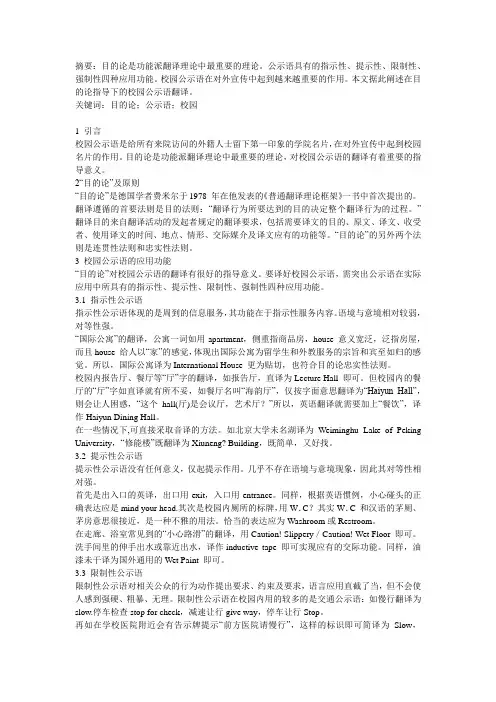
摘要:目的论是功能派翻译理论中最重要的理论。
公示语具有的指示性、提示性、限制性、强制性四种应用功能。
校园公示语在对外宣传中起到越来越重要的作用。
本文据此阐述在目的论指导下的校园公示语翻译。
关键词:目的论;公示语;校园1 引言校园公示语是给所有来院访问的外籍人士留下第一印象的学院名片,在对外宣传中起到校园名片的作用。
目的论是功能派翻译理论中最重要的理论,对校园公示语的翻译有着重要的指导意义。
2“目的论”及原则“目的论”是德国学者费米尔于1978 年在他发表的《普通翻译理论框架》一书中首次提出的。
翻译遵循的首要法则是目的法则:“翻译行为所要达到的目的决定整个翻译行为的过程。
”翻译目的来自翻译活动的发起者规定的翻译要求,包括需要译文的目的、原文、译文、收受者、使用译文的时间、地点、情形、交际媒介及译文应有的功能等。
“目的论”的另外两个法则是连贯性法则和忠实性法则。
3 校园公示语的应用功能“目的论”对校园公示语的翻译有很好的指导意义。
要译好校园公示语,需突出公示语在实际应用中所具有的指示性、提示性、限制性、强制性四种应用功能。
3.1 指示性公示语指示性公示语体现的是周到的信息服务,其功能在于指示性服务内容。
语境与意境相对较弱,对等性强。
“国际公寓”的翻译,公寓一词如用apartment,侧重指商品房,house 意义宽泛,泛指房屋,而且house 给人以“家”的感觉,体现出国际公寓为留学生和外教服务的宗旨和宾至如归的感觉。
所以,国际公寓译为International House 更为贴切,也符合目的论忠实性法则。
校园内报告厅、餐厅等“厅”字的翻译,如报告厅,直译为Lecture Hall 即可。
但校园内的餐厅的“厅”字如直译就有所不妥,如餐厅名叫“海韵厅”,仅按字面意思翻译为“Haiyun Hall”,则会让人困惑,“这个hall(厅)是会议厅,艺术厅?”所以,英语翻译就需要加上“餐饮”,译作Haiyun Dining Hall。

目的论指导下公示语翻译研究摘要:随着中国国际化进程的不断加快,公示语在社会活动中的重要性日益凸显,其翻译活动也越来越必不可少。
作者介绍公示语的语言风格,运用目的论的三个主要法则,即目的法则、连贯法则和忠实法则对其进行了分析,提出了公示语翻译应该注意的问题关键词:公示语;目的论;汉英翻译一、公示语公示语是指公开和面对公众告示、指示、提示、显示、警示、标示与其生活、生产、生命、生态、生业休戚相关的文字及图形信息,例如:问询服务(Information)、租车服务(Car Rental)、预留席位(Reserved)、售完(Sold Out)、凭票入场(Ticket Only)、严禁吸烟(No Smoking)等等。
公示语的应用范围极其广泛,许多大城市和旅游城市都使用了汉英双语的公示语。
公示语存在于生活的方方面面,彰显着城市对外开放的形象和文明程度。
但目前我国公示语的翻译状况却无法令人满意,错译、语法不通、拼写错误、违反习惯说法等问题屡见不鲜,有些译法甚至传为笑谈,严重影响了我国的国际形象。
究其原因,主要是以往的研究大都停留在微观层面上的数据收集和标示纠错阶段,而没有深入到从宏观高度上用一个可行的理论系统去指导公示语翻译二、目的论1.目的论介绍目的论(Skopostheorie)是由两位德国翻译理论家汉斯&弗米尔(Hans.J Vermeer)和凯瑟琳娜&赖斯(Katharina Reiss)于20世纪80 年代共同创立的。
它将Skopos(希腊语,意为“目的”)的概念运用于翻译的理论,其核心概念是:决定翻译过程的最主要因素是整体翻译行为的目的。
弗米尔强调,所有翻译都应遵循以下三个法则2.目的论三原则(一)目的原则1984年,弗米尔在与雷斯合著的《一般翻译理论基础》(Groundwork for a General Theory of Translation)中首次使用“目的论”的说法并对其进行了详尽的说明。
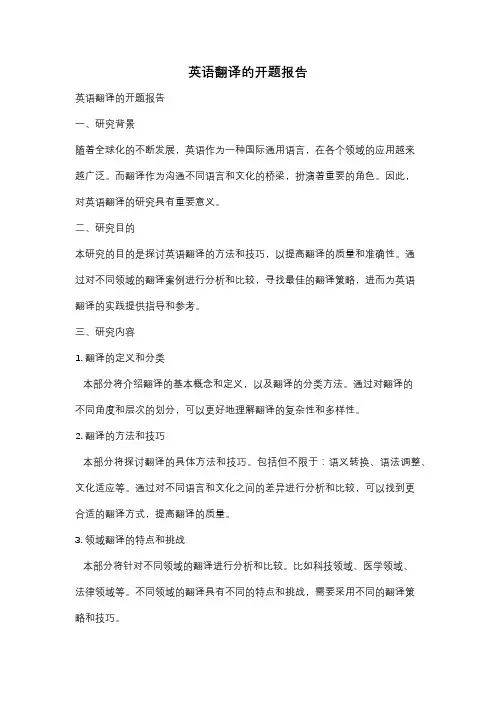
英语翻译的开题报告英语翻译的开题报告一、研究背景随着全球化的不断发展,英语作为一种国际通用语言,在各个领域的应用越来越广泛。
而翻译作为沟通不同语言和文化的桥梁,扮演着重要的角色。
因此,对英语翻译的研究具有重要意义。
二、研究目的本研究的目的是探讨英语翻译的方法和技巧,以提高翻译的质量和准确性。
通过对不同领域的翻译案例进行分析和比较,寻找最佳的翻译策略,进而为英语翻译的实践提供指导和参考。
三、研究内容1. 翻译的定义和分类本部分将介绍翻译的基本概念和定义,以及翻译的分类方法。
通过对翻译的不同角度和层次的划分,可以更好地理解翻译的复杂性和多样性。
2. 翻译的方法和技巧本部分将探讨翻译的具体方法和技巧。
包括但不限于:语义转换、语法调整、文化适应等。
通过对不同语言和文化之间的差异进行分析和比较,可以找到更合适的翻译方式,提高翻译的质量。
3. 领域翻译的特点和挑战本部分将针对不同领域的翻译进行分析和比较。
比如科技领域、医学领域、法律领域等。
不同领域的翻译具有不同的特点和挑战,需要采用不同的翻译策略和技巧。
4. 机器翻译的发展和应用本部分将介绍机器翻译的发展历程和应用情况。
随着人工智能技术的发展,机器翻译在某些领域已经取得了不错的效果。
但是机器翻译仍然存在一些问题和局限性,需要进一步的改进和研究。
5. 翻译的评价和质量控制本部分将讨论如何评价翻译的质量和进行质量控制。
通过对翻译结果的评估和分析,可以发现其中的问题和不足之处,从而提出改进建议和措施。
四、研究方法本研究将采用文献综述和案例分析的方法。
通过查阅相关文献和实际翻译案例,收集和整理相关数据,并进行分析和比较。
五、预期结果本研究预期可以总结出一套有效的英语翻译方法和技巧,为翻译实践提供指导和参考。
同时,也可以发现机器翻译的优势和不足之处,为机器翻译的改进提供建议。
六、研究意义本研究的意义在于提高英语翻译的质量和准确性,促进不同语言和文化之间的交流和理解。
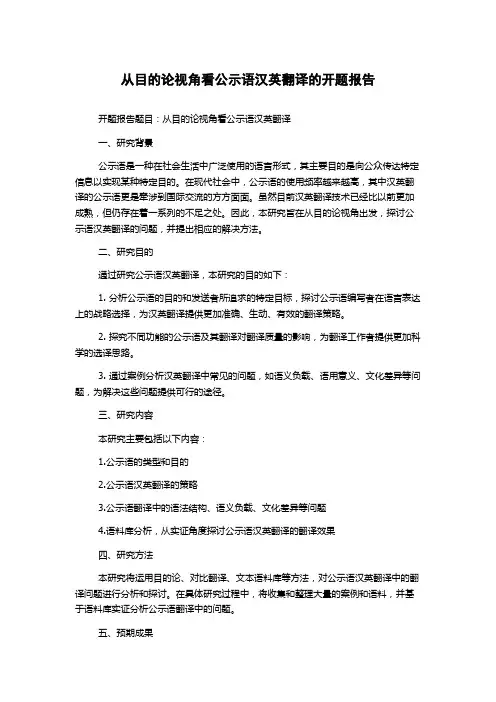
从目的论视角看公示语汉英翻译的开题报告开题报告题目:从目的论视角看公示语汉英翻译一、研究背景公示语是一种在社会生活中广泛使用的语言形式,其主要目的是向公众传达特定信息以实现某种特定目的。
在现代社会中,公示语的使用频率越来越高,其中汉英翻译的公示语更是牵涉到国际交流的方方面面。
虽然目前汉英翻译技术已经比以前更加成熟,但仍存在着一系列的不足之处。
因此,本研究旨在从目的论视角出发,探讨公示语汉英翻译的问题,并提出相应的解决方法。
二、研究目的通过研究公示语汉英翻译,本研究的目的如下:1. 分析公示语的目的和发送者所追求的特定目标,探讨公示语编写者在语言表达上的战略选择,为汉英翻译提供更加准确、生动、有效的翻译策略。
2. 探究不同功能的公示语及其翻译对翻译质量的影响,为翻译工作者提供更加科学的选译思路。
3. 通过案例分析汉英翻译中常见的问题,如语义负载、语用意义、文化差异等问题,为解决这些问题提供可行的途径。
三、研究内容本研究主要包括以下内容:1.公示语的类型和目的2.公示语汉英翻译的策略3.公示语翻译中的语法结构、语义负载、文化差异等问题4.语料库分析,从实证角度探讨公示语汉英翻译的翻译效果四、研究方法本研究将运用目的论、对比翻译、文本语料库等方法,对公示语汉英翻译中的翻译问题进行分析和探讨。
在具体研究过程中,将收集和整理大量的案例和语料,并基于语料库实证分析公示语翻译中的问题。
五、预期成果通过本研究,预期能够解决公示语汉英翻译中的难点问题,为汉英翻译工作者提供更加有效的翻译策略和技巧。
同时,还能够为公示语的编写者提供精准的信息传递方式,并在跨文化交流中保持信息的准确性和通达性。
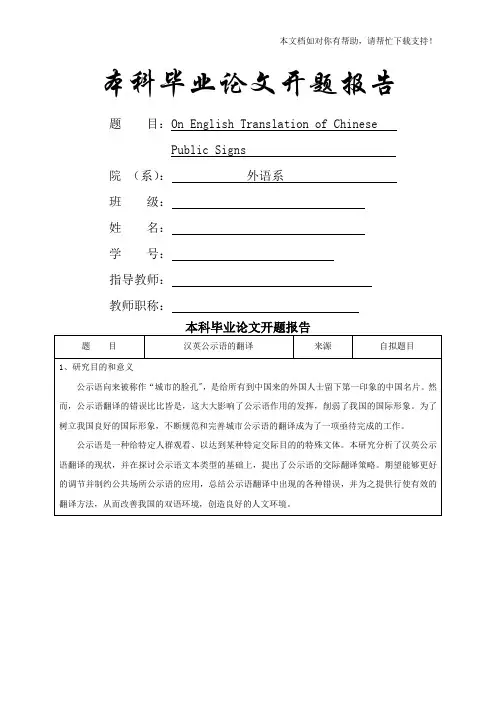
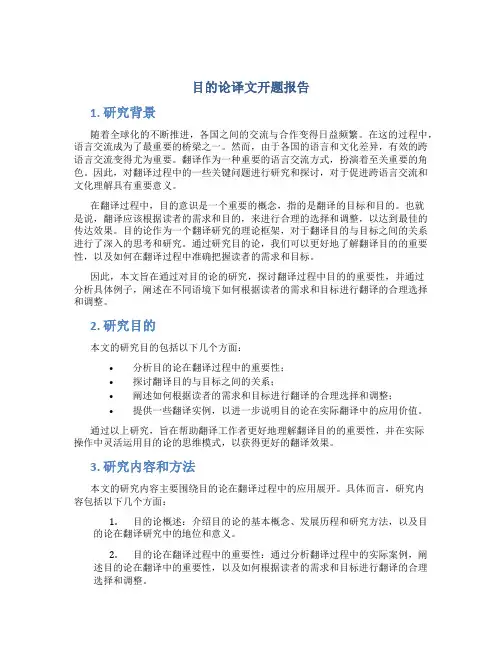
目的论译文开题报告1. 研究背景随着全球化的不断推进,各国之间的交流与合作变得日益频繁。
在这的过程中,语言交流成为了最重要的桥梁之一。
然而,由于各国的语言和文化差异,有效的跨语言交流变得尤为重要。
翻译作为一种重要的语言交流方式,扮演着至关重要的角色。
因此,对翻译过程中的一些关键问题进行研究和探讨,对于促进跨语言交流和文化理解具有重要意义。
在翻译过程中,目的意识是一个重要的概念,指的是翻译的目标和目的。
也就是说,翻译应该根据读者的需求和目的,来进行合理的选择和调整,以达到最佳的传达效果。
目的论作为一个翻译研究的理论框架,对于翻译目的与目标之间的关系进行了深入的思考和研究。
通过研究目的论,我们可以更好地了解翻译目的的重要性,以及如何在翻译过程中准确把握读者的需求和目标。
因此,本文旨在通过对目的论的研究,探讨翻译过程中目的的重要性,并通过分析具体例子,阐述在不同语境下如何根据读者的需求和目标进行翻译的合理选择和调整。
2. 研究目的本文的研究目的包括以下几个方面:•分析目的论在翻译过程中的重要性;•探讨翻译目的与目标之间的关系;•阐述如何根据读者的需求和目标进行翻译的合理选择和调整;•提供一些翻译实例,以进一步说明目的论在实际翻译中的应用价值。
通过以上研究,旨在帮助翻译工作者更好地理解翻译目的的重要性,并在实际操作中灵活运用目的论的思维模式,以获得更好的翻译效果。
3. 研究内容和方法本文的研究内容主要围绕目的论在翻译过程中的应用展开。
具体而言,研究内容包括以下几个方面:1.目的论概述:介绍目的论的基本概念、发展历程和研究方法,以及目的论在翻译研究中的地位和意义。
2.目的论在翻译过程中的重要性:通过分析翻译过程中的实际案例,阐述目的论在翻译中的重要性,以及如何根据读者的需求和目标进行翻译的合理选择和调整。
3.目的与目标的关系:分析目的与目标在翻译过程中的关系,并探讨如何根据实际情况进行合理的选择和调整,以实现更好的传达效果。
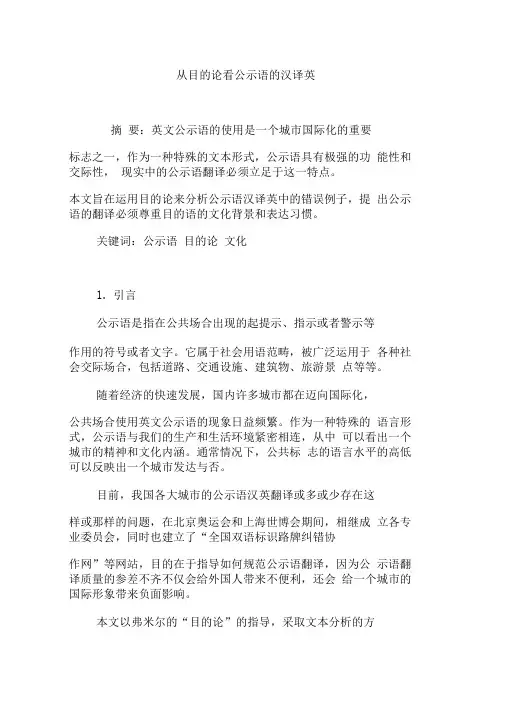
从目的论看公示语的汉译英摘要:英文公示语的使用是一个城市国际化的重要标志之一,作为一种特殊的文本形式,公示语具有极强的功能性和交际性,现实中的公示语翻译必须立足于这一特点。
本文旨在运用目的论来分析公示语汉译英中的错误例子,提出公示语的翻译必须尊重目的语的文化背景和表达习惯。
关键词:公示语目的论文化1.引言公示语是指在公共场合出现的起提示、指示或者警示等作用的符号或者文字。
它属于社会用语范畴,被广泛运用于各种社会交际场合,包括道路、交通设施、建筑物、旅游景点等等。
随着经济的快速发展,国内许多城市都在迈向国际化,公共场合使用英文公示语的现象日益频繁。
作为一种特殊的语言形式,公示语与我们的生产和生活环境紧密相连,从中可以看出一个城市的精神和文化内涵。
通常情况下,公共标志的语言水平的高低可以反映出一个城市发达与否。
目前,我国各大城市的公示语汉英翻译或多或少存在这样或那样的问题,在北京奥运会和上海世博会期间,相继成立各专业委员会,同时也建立了“全国双语标识路牌纠错协作网”等网站,目的在于指导如何规范公示语翻译,因为公示语翻译质量的参差不齐不仅会给外国人带来不便利,还会给一个城市的国际形象带来负面影响。
本文以弗米尔的“目的论”的指导,采取文本分析的方式,例举并分析公示语汉译英中的错误例子,尝试性提出公示语翻译的策略。
2.目的论作为德国最具影响力的一大译学流派,目的论于20 世纪70 年代末发展起来,代表人物-- 弗米尔在《普通翻译的理论框架》一文中首次提出翻译不能只看重形式,而应该注重文化与交际功能的目的论。
目的论学派认为:翻译不仅仅是一个转码过程,而是“种人类行为”。
人类行为都是具有目的性的,因此,有别于传统翻译理论对原文本的注重,目的论的主要关注点在于目标文本。
目的论有三大法则:2.1目的法则根据“目的决定手段”原则,翻译活动很大程度上受制于目标文本用户的情况和他们所处的文化背景。
进行任何项翻译活动之前,译者都必须立足于客户或者目标文本使用者的感受,也就是说,译者使用的翻译策略不是参照原语环境,而是必须依据目标文本的用户所处的文化背景而定。
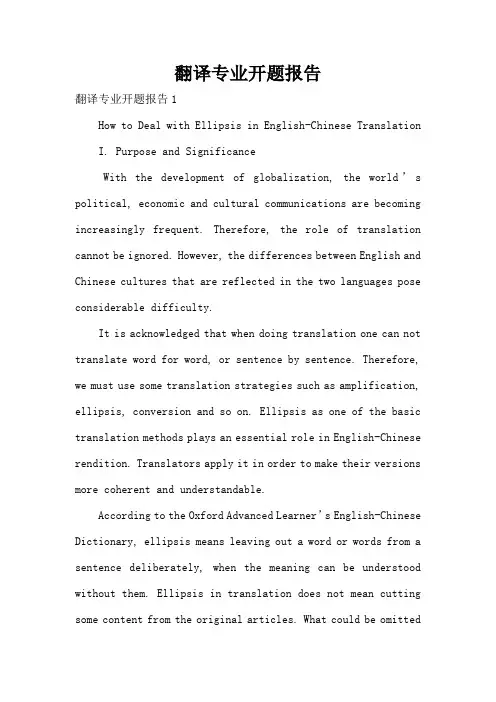
翻译专业开题报告翻译专业开题报告1How to Deal with Ellipsis in English-Chinese TranslationI. Purpose and SignificanceWith the development of globalization, the world’s political, economic and cultural communications are becoming increasingly frequent. Therefore, the role of translation cannot be ignored. However, the differences between English and Chinese cultures that are reflected in the two languages pose considerable difficulty.It is acknowledged that when doing translation one can not translate word for word, or sentence by sentence. Therefore, we must use some translation strategies such as amplification, ellipsis, conversion and so on. Ellipsis as one of the basic translation methods plays an essential role in English-Chinese rendition. Translators apply it in order to make their versions more coherent and understandable.According to the Oxford Advanced Learner’s English-Chinese Dictionary, ellipsis means leaving out a word or words from a sentence deliberately, when the meaning can be understood without them. Ellipsis in translation does not mean cutting some content from the original articles. What could be omittedare words that are useless in translated works or else they will make the versions redundant or disobey the manner of expression in another language.Some words and phrases are useless in Chinese but necessary in English. Articles in English are the most significant phenomenon from this aspect. They are very important in English, but we can hardly see any reflection of this part in Chinese. Ellipsis is designed on the basis of faithfulness to the original text, making it more fluent, smooth, concise, thus conforming to idiomatic Chinese. The paper will explore ellipsis in English-Chinese translation from five aspects, which are ellipses of pronouns, conjunctions, articles, prepositions, modifications, so as to achieve smoother and clearer communications among China and English-speaking countries.II. Literature ReviewLong before, some people began to learn other countries’languages to understand others cultures. In China, Xuanzang was the first translator who not only translated the Sanskrit sutras into Chinese, but introduced the first Chinese writings to foreign countries, making foreigners understand China’s ancient culture. Meanwhile, he was the first to translate LaoTses works into Sanskrit. Indian scholars had a high opinion of Xuanzang, In China, there is no such great translator, and also in the human cultural history, we can only say that Xuanzang is the first great translator.(Ye Lang, 20xx) We can say that it was Xuanzang who motivated people to know the different parts of the world, their cultures and the peoples who live there. Then, some big countries such as America, China, and so on became a melting pot.(Gu Zhengkun, 20xx) People have imperceptibly spent thousands of years in knowing each other.With China’s entry into WTO and its open-up policy, cross-cultural exchanges are increasingly frequent between this country and others. A lot of foreign tourists come to visit China. While traveling, these foreigners are not satisfied with the translations of the scenic spots. Sometimes, they even feel confused. A lot of problems exist in the translation, such as misuse of words, poor expression of meaning and so on. All of these poor translations do harm to our country’s international image, and cause a lot of inconveniences for the foreign visitors. (Ma Zuyi, 20xx). I am fond of tourism and being a free tourist like the others who are good at enjoying their wonderful lives. The love of tourism makes me feel the need to improve the translation. But every time when I have a trip, manyunsuitable translations of the names of those scenic spots will embarrass me. Tourism is part of intercultural communication, so proper translation of the scenic spots become more and more important to our country.Communication plays a significant role in the globalized society. In order to know each other better, people from all over the world have tried a verity of ways. Of course, translation is one of them. All translators have done their best to make the translated works more consistent with the needs of people.(Gu Jinming, 1997) From my perspective, they really have done a great job. And I want to retrospect the cause of their development. After a thorough evaluation, I choose a branch of translation—ellipsis in translation from English to Chinese, then I did the following jobs.I put all my researches and other stuffs together, and then I found that it is a common case in English and Chinese which draws much academic interest. In 1976, Halliday and Hsan classified ellipsis into nominal, verbal and clausal ellipsis. This classification exerts great influence in academic circle. Thereafter, ellipsis in Chinese and English has been studied according to this theory, which is based on different layers of structure. This kind of study underlines differentiationsand similarities of ellipsis in Chinese and English.Another famous theory to explain ellipsis is Economy Principle. Economy Principle was put forward by Chomsky (1991,1993, and 1995) in his Generate Crammer. It maintains that language and linguistic study follow Economy Principle, which means using the least effort to express the most information. This principle just coincides with ellipsis in function.In this thesis, I think that brevity is the most obvious and common function of ellipsis, especially in daily language. And in both English and Chinese, people advocate brevity. Shakespeare once remarked, “brevity is the soul of wit”, and in Chinese there are numerous idioms like “yan jian yi gai” (meaning compendious). However, apart from the function of brevity, ellipsis embodies other functions which are also pretty common in the two languages but less noticed.(Hua Xianfa,20xx)These functions distribute in both English and Chinese unevenly and represent great colorfulness of language. Exploring other functions of ellipsis and searching for functional recreation in translation will be of much benefit to both English to Chinese and Chinese to English translation.I found that when Chinese authors try to analyse ellipsisin English to Chinese translation, they always initially put articles in the list. They consider that it is a common phenomenon that Chinese always leave out personal articles. While it is obviously different in English that almost every sentence has a subject, we can see articles fluently. That is because when we translate from English to Chinese, personal articles can be omitted, even though sometimes it may appear once, it can also be omitted if necessary. Furthermore, if the objects can be seen obviously, personal articles should also be omitted. However, it never happens in English. From this point, it is not only allowable but also necessary when we translate personal articles which are objects in sentences into Chinese.In my point of view, the development of society has in some way has deliberately promoted the way of people’s thinking, translation system has become more and more perfect, people from all over the world have enjoyed the convenience. However, we can not neglect that there are still some problems in this field in China, and we have less influential Chinese translators in the world. Therefore, we still have a long way to go in translation.III. Feasibility AnalysisThis academic paper is a feasible project and the reasons are as follows:1.I have great interests in the way of English-Chinese translation.2.I have already studied translation methods and have been familiar with the functions and applications of ellipsis .3.I have collected enough references both Chinese and Western on ellipsis intranslation and do a scrupulous study of the relationship between them.4.I have a carefully planned schedule and have worked outa detailed outline of this thesis.5.I have acquainted myself with the correct format, a clear and complete structure required by the academic paper, and my adequate English competence will enable me to write in fluent and precise English.6.My instructor is a qualified translator who is familiar with the subject I havechosen.IV. Problems of the research and solutions1. ProblemsDespite the references I have collected and read, a thorough study of ellipsis in English-Chinese translation fromthe point of freely using still needs far more. What’s more, owing to the limited ways of getting references in Xinjiang, I will have to make full use of my present resources. Also, this is the first time I have ever written such a serious academic paper. I am therefore a learner and lack the needed training and experience.2. Solutions(1) I shall make full use of my already acquired references which come from books, magazines and the Internet as well.(2) I shall value my own original thoughts and mainly rely on detailed analysis that I have read from the books which have closely idea with my purpose.(3) When I have difficulties in the writing process, I shall consult my instructor and seek for help.V. Necessary conditions1. Our university and school of foreign languages have provided the basic study and research conditions and facilities, including books and journals in the library and reading rooms.2. The Internet is another source of information and on the campus we have easy access to the Internet.3. I have been assigned an instructor to guide me through the whole process of planning and writing.VI. OutlineI. IntroductionA. A Brief Introduction of Ellipsis in TranslationB. What Should We Pay Attention to When Dealing with EllipsisC. The Reason Why Ellipsis Is So Widely Used in Translation1. Chinese Expressions Are Much Briefer Than That of English2. English Grammar Is Wee-Knit and Complete in Sentence StructureII. The Principles of EllipsisA. Omitted Words Must Be Useless And Unnecessary in the Translated WorksB. The Meaning of the Omitted Words Is Implied in the TestC. Omitted Words Which Are Self-EvidentШ. The Functions and Applications of EllipsisA. The Coherence of the Meaning of ExpressionB. The Coincidence of the Manner of Expression1. Ellipsis of Articlesa. Ellipsis of Definite Articlesb. Ellipsis of Indefinite Articles2. Ellipsis of Prepositions3. Ellipsis of Pronounsa. Ellipsis of Personal and Impersonal Pronounsb. Ellipsis of Indefinite Pronounsc. Ellipsis of Relative Pronouns4. Ellipsis of Conjunctionsa. Ellipsis of Coordinating Conjunctionsb. Ellipsis of Subordinate Conjunctions5. Ellipsis of Rhetorica. Ellipsis of Repeated Wordsb. Ellipsis of Synonyms翻译专业开题报告2选题的原因、基本内容:英语成语(idiom)是英语的核心与精华。


目的论视角下的翻译开题报告
本报告旨在从目的论视角讨论翻译开题方面的相关研究问题。
回
顾国内外国际文化交流发展的历程,伴随而来的是跨文化交流的概念
的不断发展,翻译作为有效的跨文化交流方式之一,其重要性不言而喻。
针对翻译这一领域,本报告将从目的论的视角,着重探讨与翻译
开题相关的研究问题,研究其大体步骤、主要内容及存在的问题,以
期为将来的翻译研究提供参考。
从目的论视角来看,翻译开题是翻译研究者深入探讨翻译理论及
实践的重要第一步。
翻译开题的目标以把握普遍性法则为基础,以深
刻理解目标语文化为主要组成部分,力求提供准确、有价值及实用的
翻译方向意见。
开题内容至少应包括四部分:(1) 确定源语文本的基
本定义;(2)提示目标语的文化背景;(3)界定翻译对象;(4)暗示翻译
风格。
翻译开题是翻译过程中的关键步骤,但也存在着一定的弊端。
首先,翻译开题中的文化定义常常有偏差,影响翻译质量;其次,不同
文化之间有着不确定性,文化定义受到源语文本获取、目标语文化掌
握以及翻译者个人知识等诸多因素的限制;最后,针对某一特定语种,翻译者有可能忽视翻译环境的多元化性,这将影响其翻译的准确性。
本报告旨在从目的论的视角,深度剖析翻译开题的概念与步骤,
探讨翻译开题中存在的弊端;同时,为翻译研究者提供有价值及实用
的参考,以指导其日常翻译实践。
模因论视角下的汉英公示语翻译的开题报告一、研究背景及意义随着全球化的加速推进,跨文化交流与交融成为当今社会的一个普遍现象。
在这样的背景下,汉英翻译的需求越来越迫切。
其中,公示语是重要的文化载体之一,它不仅作为信息传递的媒介,而且也是一种文化符码,具有深刻的文化内涵。
然而,在汉英翻译的实践过程中,因为中英两种语言的根本差异,译者需要在语义、语用、文化背景等多个方面进行准确的处理,这也使得汉英公示语的翻译具有一定的挑战性。
基于此,本文将从模因论的视角出发,探讨不同文化背景下汉英公示语的翻译策略和规律,以期为实现更为准确、贴切的汉英公示语翻译提供借鉴和参考。
二、研究内容及方法2.1 研究内容本文将选取一些具有代表性的汉英公示语作为研究对象,从语义、语用和文化背景三个层面进行深入分析,结合模因论的相关理论,探讨汉英公示语翻译的策略和规律。
2.2 研究方法本研究将采用语料库及文献分析法,首先将汇总一些常见的汉英公示语并建立语料库,接下来将利用现有的研究成果和相关文献,对各种公示语进行分类和分析,然后从模因论的角度出发,对汉英公示语的翻译进行探讨和归纳。
此外,本研究也将采用访谈法,对相关的汉英翻译专家进行采访和讨论,借鉴其经验和观点。
三、研究计划及进度安排3.1 研究计划第一阶段:收集语料及文献调研。
本阶段将汇总一些常见的汉英公示语,并建立起相应的语料库,同时也将调研与汉英公示语相关的文献和研究成果。
第二阶段:分类与分析汉英公示语。
在此阶段,将对收集到的语料进行分类和分析,探究其中的语言、文化和语用等方面的特点。
第三阶段:模因论视角下的汉英公示语翻译探讨。
在此阶段,将首先介绍模因论的相关理论,然后将该理论应用于汉英公示语的翻译中,探讨其策略和规律。
第四阶段:调研和讨论。
本阶段将与相关汉英翻译专家进行访谈和讨论,借鉴他们在实践中的经验和观点,进一步完善本文的研究成果。
第五阶段:撰写论文。
完成以上各项工作后,将在此阶段撰写详实的论文,并对其进行逐步修改和完善。
目的论译文开题报告目的论译文开题报告一、选题背景随着全球化的深入发展,跨文化交流和合作日益频繁,翻译作为一种跨越语言和文化的沟通工具,扮演着重要的角色。
然而,由于不同语言和文化之间的差异,翻译过程中常常会出现信息丢失、语义偏差等问题。
为了解决这些问题,翻译研究领域涌现出了各种翻译理论和方法。
其中,目的论翻译理论因其强调翻译的目的和功能,对翻译实践具有重要意义。
本文将以目的论翻译理论为基础,探讨其在翻译实践中的应用。
二、研究目的本文旨在通过分析目的论翻译理论的基本原理和应用方法,深入探讨其在翻译实践中的应用价值和局限性。
通过对目的论翻译理论的研究,可以帮助翻译从业者更好地理解翻译的目的和功能,提高翻译质量和效率。
三、研究内容1. 目的论翻译理论的基本原理本节将介绍目的论翻译理论的基本概念和原理,包括目的论翻译的定义、目的论翻译的主要观点以及目的论翻译与其他翻译理论的关系等内容。
2. 目的论翻译在文学翻译中的应用本节将以文学翻译为例,探讨目的论翻译在文学翻译中的应用。
文学作品具有独特的文化背景和艺术风格,翻译时需要考虑如何保持原作的风采和表达方式。
通过分析目的论翻译理论在文学翻译中的应用,可以帮助翻译从业者更好地理解和传达原作的意图和情感。
3. 目的论翻译在商务翻译中的应用本节将以商务翻译为例,探讨目的论翻译在商务翻译中的应用。
商务翻译要求准确传达商务信息和交流意图,同时考虑到不同文化背景和商务约定的差异。
通过分析目的论翻译理论在商务翻译中的应用,可以帮助翻译从业者更好地理解和传达商务信息,增进跨文化商务合作的顺利进行。
4. 目的论翻译的局限性和挑战本节将分析目的论翻译理论的局限性和面临的挑战。
目的论翻译理论强调翻译的目的和功能,但在实际应用中,如何准确理解原作的目的和传达目的成为一个难题。
同时,不同文化和社会背景之间的差异也给目的论翻译带来了一定的挑战。
四、研究方法本文将采用文献综述和案例分析相结合的方法进行研究。
英语翻译专业论文开题报告英语翻译专业论文开题报告一、研究背景和意义随着全球化的不断深入,英语翻译专业的重要性日益凸显。
在跨文化交流和国际合作中,翻译作为一种重要的沟通工具,扮演着桥梁的角色。
然而,在实际的翻译实践中,我们常常会遇到各种问题和挑战,如语言难度、文化差异、专业术语等。
因此,本论文旨在研究英语翻译专业的相关问题,提出解决方案,以提高翻译质量和效率。
二、研究目标和内容本论文的目标是通过对英语翻译专业的研究,探讨以下几个方面的内容:1. 翻译理论与实践的关系:探讨翻译理论对实际翻译工作的指导作用,分析理论与实践之间的差距和联系。
2. 语言难度与处理方法:研究英语翻译中常见的语言难点,如语法结构、词汇选择等,提出相应的处理方法和技巧。
3. 文化差异与翻译策略:分析不同文化背景下的翻译难题,如习语、典故等,提出适应性的翻译策略。
4. 专业术语的翻译与标准化:研究专业术语在翻译中的问题和挑战,探讨术语翻译的标准化方法和规范。
5. 翻译质量评估与提升:探讨翻译质量评估的方法和标准,提出提升翻译质量的措施和建议。
三、研究方法本论文采用综合性的研究方法,包括文献调研、实证研究和案例分析。
首先,通过对相关文献的梳理和分析,了解当前英语翻译专业的研究现状和发展趋势。
其次,进行实证研究,通过问卷调查、访谈等方式,收集实际翻译工作者和用户的意见和经验。
最后,通过案例分析,对翻译实践中的问题和挑战进行深入剖析。
四、论文结构本论文将分为以下几个部分:1. 引言:介绍研究背景和意义,阐述研究目标和内容,概述研究方法和论文结构。
2. 理论框架:综述相关的研究文献,介绍翻译理论和实践之间的关系,为后续研究提供理论支持。
3. 语言难度与处理方法:分析英语翻译中的语言难点,提出相应的处理方法和技巧,以提高翻译质量和效率。
4. 文化差异与翻译策略:探讨不同文化背景下的翻译难题,提出适应性的翻译策略,以促进跨文化交流和理解。
5. 专业术语的翻译与标准化:研究专业术语在翻译中的问题和挑战,探讨术语翻译的标准化方法和规范,以提高翻译质量和一致性。
Student NameCai HongyanAnticipated Graduation(Month and Y ear)2013-06Research Title & Subtitle(both in English and Chinese)(E) A Brief Study of Tourism Signs Translation from the Perspective of Skopos Theory——A Case of Liaoning Provincial Museum(C) 从目的论的视角看旅游公示语的翻译——辽宁省博物馆个案分析Thesis Proposal Abstract(Max. 200 words, one paragraph)1.Background and context 研究背景2. Research focus 研究重点3. Methodology 研究方法1.Background and contextIn China, the translation of public signs really started in 1989, scholars and people with breadth of vision on the translation of public signs made continuous exploration and research, which has yielded encouraging results. But generally speaking, the translation of public signs in China started late, lack of systematic and normative, errors and problems still very prominent.2. Research focusThis paper uses the German functionalist Skopos theory to guide the study of Chinese-English translation of public signs and tries to offer some solutions. Regarding Liaoning Provincial Museum as the case to analyze, I find out the causes of the errors, summarize public signs translation methods. Translation of public signs as the starting point, some suggestion will be put forward for the future developme nt of the translation.3. MethodologySearch information on the Internet or in the library;Take some pictures in Liaoning Provincial Museum. Analyze and study.Research Questions(1-3 with sub-questions if necessary)1. Study of the characteristics, significance and current situation of the public signs;2 to apply German functionalist Skopos theory and try to provide the corresponding translation strategies for the translation of public signs;3. Liaoning Provincial Museum as the case to analyze and find out the causes of wrong translation and summarize the methods of the translation of public signs;Advisor Approval_____________________ __________________ ____________________ Thesis Advisor (Print) Signature (Chinese) Date_____________________ ___________________ _____________________ Student Name (Print) Signature (Chinese) DateTHESIS PROPOSAL OUTLINEI.INTRODUCTION 导言1.Introduction to the subject (A brief background of the topic and the problem space.2.Importance of subject (Why is the topic of your research valuable.)3.Intention of the study (Intended contribution to the discipline.)关键词:选题背景;选题价值;学术贡献1.Introduction to the subjectReform and opening up for 30 years, China has kept increasingly close communication with the world’s people. Tens of thousands of foreign students, workers and tourists have been pouring into China. With great contribution to be convenient for others, regulate behaviors and adjust interpersonal relationship, public signs play a very important role in our daily life; But meanwhile, in such service industry as hotels, tourist attractions or museums, and even in such public places as Streets, shopping malls, there exists wrong or non-standard foreign language signs everywhere. Therefore, the studies and translation of the public signs should be resolved with the urgent expectation and strict requirements.2. Importance of subjectThe sign translation is an important component part in the foreign-oriented publicity in China.Whether the sign translation realizes the signs original function not only influences the basic necessities of lives of foreign friends but also relates to the urban mental outlook,thereby influencing the international image of China.Consequently, we should pay close attention to the sign translation.By this thesis,the author aims at drawing more attention on the sign translation and making our country more open and modem.3.Intention of the studyAt the same time, the paper regards the German functional Skopos Theory as reliable theory basis of translation of public signs, which elaborates the application of Skopos Theory, and the methods and strategies in the translation of public signs aiming at effectively guiding the Chinese-English translation of public signs.II.LITERATURE REVIEW 文献综述1.History and related research of the topic ( A condensed literature review will beexpanded in the final thesis)2.Research questions or hypotheses ( The literature review should naturally and logicallylead to the research questions or hypothesis)关键词:该领域的历史与现状(简述);研究问题或假设(应得到文献综述的支持)1.History and related research of the topicV ermeer pushes Skopos theory to a new height by proposing his "Theory of Translation Action." He thinks that every human action has its specific purpose Translation is a kind of human-specific action.There are three important rules in Skopos theory.The top-ranking rule is the ‘Skopos rule,which says that a translational action is determined by its Skopos;(Reiss and Vermeer 1 984:1 0 1).The second important rule of Skopos theory is the ‘coherence rule’,specifying that a translation should be acceptable in a sense that it is coherent with the receivers’ situation(Reiss and Vermeer 1 984:113).The third rule is referred to as a ‘fidelity rule’ by Reiss and Vermeer(R eiss and Vermeer 1 984:1 14),which is similar to the theory of faithfulness in other translation theories.2.Research questions or hypothesesThis paper uses the German functionalist Skopos theory to guide the study of Chinese-English translation of public signs and tries to offer some solutions. Regarding Liaoning Provincial Museum as the case to analyze, I find out the causes of the errors, summarize public signs translation methods. Translation of public signs as the starting point, some suggestion will be put forward for the future development of the translation.III.METHODOLOGY 研究方法1.The overall research design2.Participants3.Procedures ( How the study will be carried out)4.Data analysis关键词:整体性的研究设计研究步骤数据分析1) Preparatory stage: mainly complete topic selection, looking for, reading and assembling materials.2) Writing stage: write a first draft.3) Modification stage: gain the feedbacks from the instructors and other people. Revise carefully and write the second draft.4) Editing stage: Lay more emphasis on word expressions, formats and correction of language errors and spelling errors. Write the finalized.IV.REFERENCES 参考文献关键词:10-15条,仅限反映该领域的历史与前沿的重要文献和文献综述部分提到的文献注意:参考文献的格式根据研究领域分为MLA和APA。
Student NameCai HongyanAnticipated Graduation(Month and Y ear)2013-06Research Title & Subtitle(both in English and Chinese)(E) A Brief Study of Tourism Signs Translation from the Perspective of Skopos Theory——A Case of Liaoning Provincial Museum(C) 从目的论的视角看旅游公示语的翻译——辽宁省博物馆个案分析Thesis Proposal Abstract(Max. 200 words, one paragraph)1.Background and context 研究背景2. Research focus 研究重点3. Methodology 研究方法1.Background and contextIn China, the translation of public signs really started in 1989, scholars and people with breadth of vision on the translation of public signs made continuous exploration and research, which has yielded encouraging results. But generally speaking, the translation of public signs in China started late, lack of systematic and normative, errors and problems still very prominent.2. Research focusThis paper uses the German functionalist Skopos theory to guide the study of Chinese-English translation of public signs and tries to offer some solutions. Regarding Liaoning Provincial Museum as the case to analyze, I find out the causes of the errors, summarize public signs translation methods. Translation of public signs as the starting point, some suggestion will be put forward for the future developme nt of the translation.3. MethodologySearch information on the Internet or in the library;Take some pictures in Liaoning Provincial Museum. Analyze and study.Research Questions(1-3 with sub-questions if necessary)1. Study of the characteristics, significance and current situation of the public signs;2 to apply German functionalist Skopos theory and try to provide the corresponding translation strategies for the translation of public signs;3. Liaoning Provincial Museum as the case to analyze and find out the causes of wrong translation and summarize the methods of the translation of public signs;Advisor Approval_____________________ __________________ ____________________ Thesis Advisor (Print) Signature (Chinese) Date_____________________ ___________________ _____________________ Student Name (Print) Signature (Chinese) DateTHESIS PROPOSAL OUTLINEI.INTRODUCTION 导言1.Introduction to the subject (A brief background of the topic and the problem space.2.Importance of subject (Why is the topic of your research valuable.)3.Intention of the study (Intended contribution to the discipline.)关键词:选题背景;选题价值;学术贡献1.Introduction to the subjectReform and opening up for 30 years, China has kept increasingly close communication with the world’s people. Tens of thousands of foreign students, workers and tourists have been pouring into China. With great contribution to be convenient for others, regulate behaviors and adjust interpersonal relationship, public signs play a very important role in our daily life; But meanwhile, in such service industry as hotels, tourist attractions or museums, and even in such public places as Streets, shopping malls, there exists wrong or non-standard foreign language signs everywhere. Therefore, the studies and translation of the public signs should be resolved with the urgent expectation and strict requirements.2. Importance of subjectThe sign translation is an important component part in the foreign-oriented publicity in China.Whether the sign translation realizes the signs original function not only influences the basic necessities of lives of foreign friends but also relates to the urban mental outlook,thereby influencing the international image of China.Consequently, we should pay close attention to the sign translation.By this thesis,the author aims at drawing more attention on the sign translation and making our country more open and modem.3.Intention of the studyAt the same time, the paper regards the German functional Skopos Theory as reliable theory basis of translation of public signs, which elaborates the application of Skopos Theory, and the methods and strategies in the translation of public signs aiming at effectively guiding the Chinese-English translation of public signs.II.LITERATURE REVIEW 文献综述1.History and related research of the topic ( A condensed literature review will beexpanded in the final thesis)2.Research questions or hypotheses ( The literature review should naturally and logicallylead to the research questions or hypothesis)关键词:该领域的历史与现状(简述);研究问题或假设(应得到文献综述的支持)1.History and related research of the topicV ermeer pushes Skopos theory to a new height by proposing his "Theory of Translation Action." He thinks that every human action has its specific purpose Translation is a kind of human-specific action.There are three important rules in Skopos theory.The top-ranking rule is the ‘Skopos rule,which says that a translational action is determined by its Skopos;(Reiss and Vermeer 1 984:1 0 1).The second important rule of Skopos theory is the ‘coherence rule’,specifying that a translation should be acceptable in a sense that it is coherent with the receivers’ situation(Reiss and Vermeer 1 984:113).The third rule is referred to as a ‘fidelity rule’ by Reiss and Vermeer(R eiss and Vermeer 1 984:1 14),which is similar to the theory of faithfulness in other translation theories.2.Research questions or hypothesesThis paper uses the German functionalist Skopos theory to guide the study of Chinese-English translation of public signs and tries to offer some solutions. Regarding Liaoning Provincial Museum as the case to analyze, I find out the causes of the errors, summarize public signs translation methods. Translation of public signs as the starting point, some suggestion will be put forward for the future development of the translation.III.METHODOLOGY 研究方法1.The overall research design2.Participants3.Procedures ( How the study will be carried out)4.Data analysis关键词:整体性的研究设计研究步骤数据分析1) Preparatory stage: mainly complete topic selection, looking for, reading and assembling materials.2) Writing stage: write a first draft.3) Modification stage: gain the feedbacks from the instructors and other people. Revise carefully and write the second draft.4) Editing stage: Lay more emphasis on word expressions, formats and correction of language errors and spelling errors. Write the finalized.IV.REFERENCES 参考文献关键词:10-15条,仅限反映该领域的历史与前沿的重要文献和文献综述部分提到的文献注意:参考文献的格式根据研究领域分为MLA和APA。